TheDeveloperBlog.com
C-Sharp | Java | Python | Swift | GO | WPF | Ruby | Scala | F# | JavaScript | SQL | PHP | Angular | HTML
DBMS ER model concept
DBMS ER model concept with DBMS Overview, DBMS vs Files System, DBMS Architecture, Three schema Architecture, DBMS Language, DBMS Keys, DBMS Generalization, DBMS Specialization, Relational Model concept, SQL Introduction, Advantage of SQL, DBMS Normalization, Functional Dependency, DBMS Schedule, Concurrency Control etc.
ER model
For example, Suppose we design a school database. In this database, the student will be an entity with attributes like address, name, id, age, etc. The address can be another entity with attributes like city, street name, pin code, etc and there will be a relationship between them. 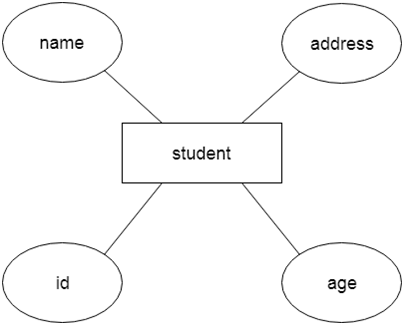
Component of ER Diagram
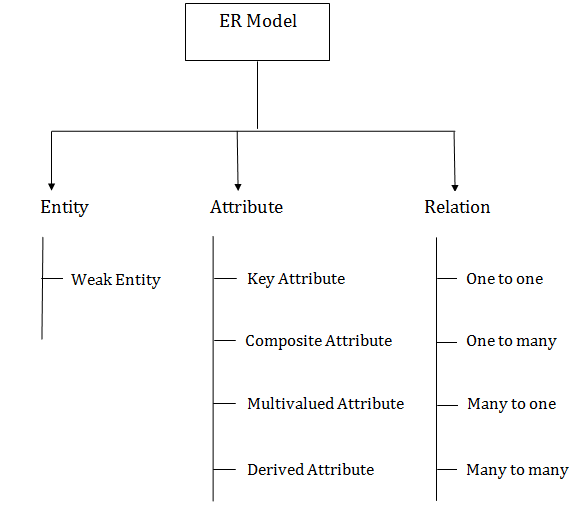
1. Entity:An entity may be any object, class, person or place. In the ER diagram, an entity can be represented as rectangles. Consider an organization as an example- manager, product, employee, department etc. can be taken as an entity. 
a. Weak Entity An entity that depends on another entity called a weak entity. The weak entity doesn't contain any key attribute of its own. The weak entity is represented by a double rectangle. 
2. AttributeThe attribute is used to describe the property of an entity. Eclipse is used to represent an attribute. For example, id, age, contact number, name, etc. can be attributes of a student. 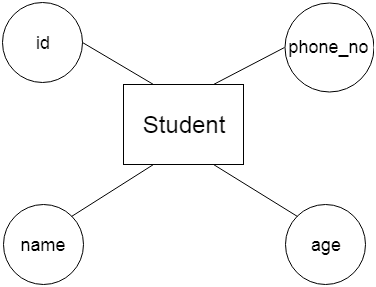
a. Key Attribute The key attribute is used to represent the main characteristics of an entity. It represents a primary key. The key attribute is represented by an ellipse with the text underlined. 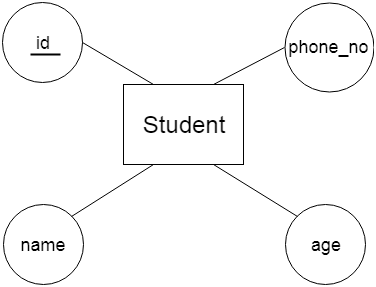
b. Composite Attribute An attribute that composed of many other attributes is known as a composite attribute. The composite attribute is represented by an ellipse, and those ellipses are connected with an ellipse. 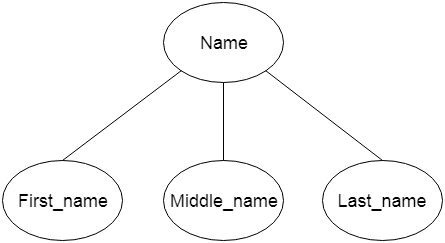
c. Multivalued Attribute An attribute can have more than one value. These attributes are known as a multivalued attribute. The double oval is used to represent multivalued attribute. For example, a student can have more than one phone number. 
d. Derived Attribute An attribute that can be derived from other attribute is known as a derived attribute. It can be represented by a dashed ellipse. For example, A person's age changes over time and can be derived from another attribute like Date of birth. 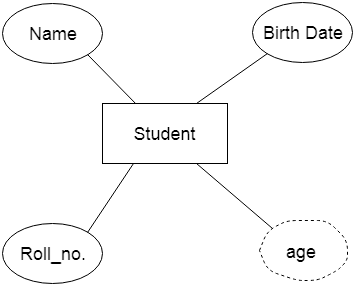
3. RelationshipA relationship is used to describe the relation between entities. Diamond or rhombus is used to represent the relationship. 
Types of relationship are as follows: a. One-to-One Relationship When only one instance of an entity is associated with the relationship, then it is known as one to one relationship. For example, A female can marry to one male, and a male can marry to one female. 
b. One-to-many relationship When only one instance of the entity on the left, and more than one instance of an entity on the right associates with the relationship then this is known as a one-to-many relationship. For example, Scientist can invent many inventions, but the invention is done by the only specific scientist. 
c. Many-to-one relationship When more than one instance of the entity on the left, and only one instance of an entity on the right associates with the relationship then it is known as a many-to-one relationship. For example, Student enrolls for only one course, but a course can have many students. 
d. Many-to-many relationship When more than one instance of the entity on the left, and more than one instance of an entity on the right associates with the relationship then it is known as a many-to-many relationship. For example, Employee can assign by many projects and project can have many employees. 
Next TopicDBMS Notation for ER diagram
|
Related Links:
- DBMS Multivalued Dependency
- DBMS Inclusion Dependence
- DBMS SQL Set Operation
- Top 52 DBMS Interview Questions (2021)
- DBMS Transaction Processing Concept
- DBMS States of Transaction
- DBMS Schedule
- DBMS Conflict Serializable Schedule
- DBMS View Serializability
- DBMS Recoverability of Schedule
- DBMS Tutorial | Database Management System
- DBMS Failure Classification
- DBMS Concurrency Control
- DBMS Lock based Protocol
- DBMS Log-Based Recovery
- DBMS Checkpoint
- DBMS Timestamp Ordering Protocol
- DBMS Validation based Protocol
- DBMS Thomas Write Rule
- DBMS Multiple Granularity
- DBMS Sequential File Organization
- DBMS Recovery Concurrent Transaction
- DBMS Characteristics of SQL
- DBMS File organization
- DBMS Heap File Organization
- DBMS Hash File Organization
- DBMS B+ Tree
- DBMS RAID
- DBMS B+ File Organization
- DBMS Indexed Sequential Access Method
- DBMS Cluster File Organization
- DBMS Hashing
- DBMS Static Hashing
- DBMS Dynamic Hashing
- DBMS SQL Introduction
- DBMS Advantage of SQL
- SQL Commands: DDL, DML, DCL, TCL, DQL
- DBMS SQL Operator
- DBMS SQL Insert
- DBMS SQL Update
- DBMS SQl Datatype
- DBMS SQL Table
- DBMS SQL Select
- DBMS SQL Index
- DBMS SQL Sub Queries
- DBMS SQL Clauses
- DBMS Generalization
- DBMS Specialization
- DBMS vs Files System
- DBMS Architecture
- DBMS SQL Delete
- DBMS SQL View
- DBMS Three schema Architecture
- DBMS Data model schema and Instance
- DBMS Join Operation
- DBMS Notation for ER diagram
- DBMS Relational Calculus
- DBMS Data Independence
- DBMS Language
- DBMS ER model concept
- DBMS Mapping constraints
- DBMS Keys: Primary, Foreign, Candidate and Super Key
- DBMS Aggregation
- DBMS Join Dependency
- DBMS Convert ER into table
- DBMS Relationship of Higher Degree
- DBMS Relational Model concept
- DBMS Relational Algebra
- DBMS Integrity Constraints
- DBMS Functional Dependency
- DBMS Inference Rule
- DBMS Normalization: 1NF, 2NF, 3NF and BCNF with Examples
- DBMS Transaction Property
- DBMS Testing of Serializability
- DBMS 1NF
- DBMS 2NF
- DBMS SQL Aggregate function
- DBMS SQL Joins
- DBMS 3NF
- DBMS BCNF
- DBMS 4NF
- DBMS 5NF
- DBMS Relational Decomposition

